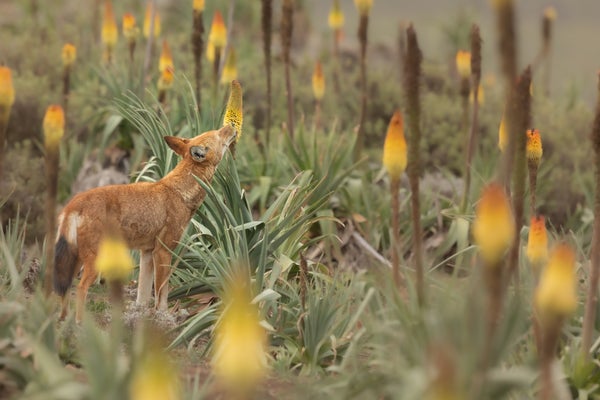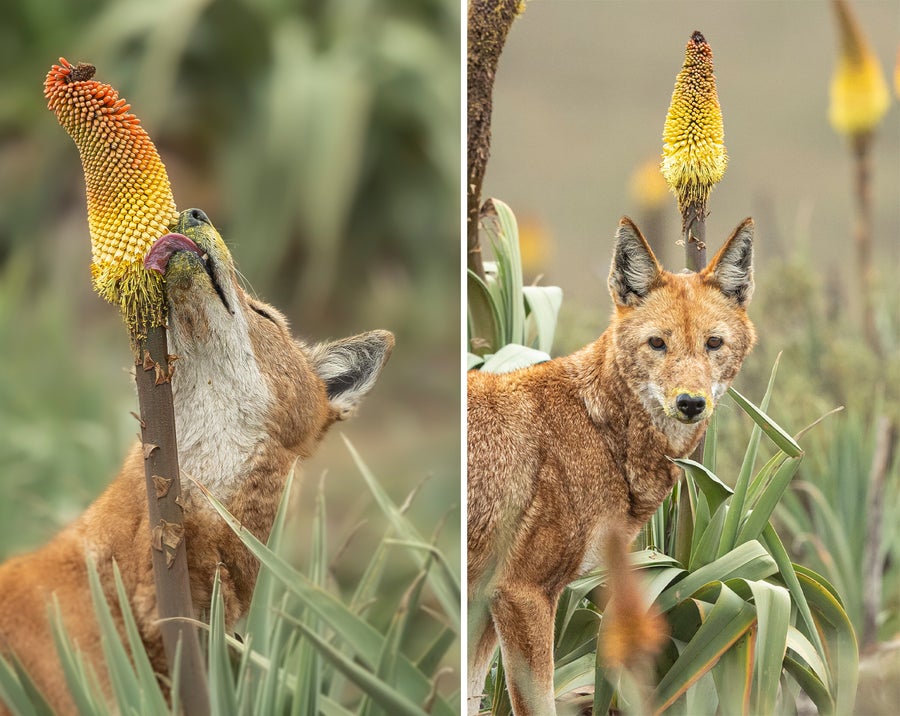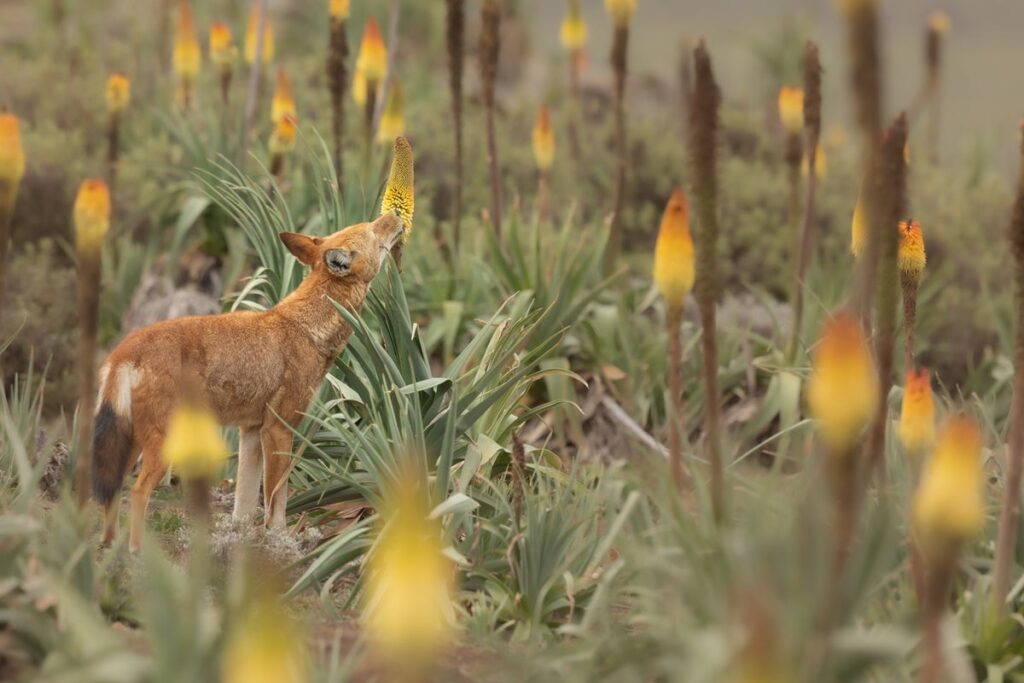[ad_1]
December 3, 2024
3 min read
Nectar-Eating Wolves May Be Pollinating Flowers
There are fewer than 500 Ethiopian wolves, and they may be the first large carnivore known to act as a pollinator

An Ethiopian wolf (Canis simensis) feeding amongst the blooming Ethiopian red hot poker flowers (Kniphofia foliosa).
An Ethiopian wolf’s diet is pretty basic: its proverbial meat and potatoes consists of a large rodent called a giant mole rat (which is meat but looks rather like a fuzzy potato). But it turns out that the endangered canid also has a sweet tooth. It regularly laps up sugary nectar from a tall, fiery-hued flower that adorns the animal’s high-elevation ecosystem. In the process, the wolf may be serving as a pollinator, a role usually occupied by insects, birds and flying mammals—not large carnivores.
That hypothesis comes from a team at the Ethiopian Wolf Conservation Program, which published their observations on November 19 in the journal Ecology. For years, the group’s monitors have noticed the occasional wolf drinking the nectar from a local flower called the Ethiopian red hot poker (Kniphofia foliosa), which blooms from June to November and looks something like a large, fuzzy matchstick set aflame. (Its nectar is also popular with children and baboons, says Sandra Lai, an ecologist at the University of Oxford and the Ethiopian Wolf Conservation Program, who is a co-author of the new research.)
Despite the known reports about nectar drinking, the researchers were surprised by what they learned from systematically observing the wolves. “They spend a lot of time actually foraging on the flowers,” Lai says. “They can stay, like, an hour and a half going from flower to flower. We’ve seen one individual going consecutively to 30 flowers.” In addition, the researchers saw the behavior among members of different packs, suggesting that the nectar-feasting is a widespread habit, not a local quirk.
On supporting science journalism
If you’re enjoying this article, consider supporting our award-winning journalism by subscribing. By purchasing a subscription you are helping to ensure the future of impactful stories about the discoveries and ideas shaping our world today.

An Ethiopian wolf (Canis simensis) licks nectar from the Ethiopian red hot poker flower (Kniphofia foliosa) (left) and with its muzzle covered in pollen after feeding on the nectar (right).
The new report doesn’t surprise Anagaw Atickem, an ecologist at Addis Ababa University in Ethiopia. He was not involved in the new research but has studied how domestic dogs compete with Ethiopian wolves, and he noticed in the process that the dogs have a taste for the red hot poker flowers. Based on the new paper’s finding, he wonders whether sharing the flowers may even allow the spread of diseases between the dogs and the wolves.
Both Atickem and Lai say there’s a lot more to learn about the behavior and its importance. The wolves end up with a muzzle covered in pollen, raising the possibility that they may be transporting it between flowers and pollinating them in the process. If they are, the wolves would be among the first known large carnivores that facilitate plant reproduction in this way. Pollination is more commonly associated with insects, birds and flying mammals, Lai says; scientists are only beginning to consider ground-bound mammals such as mice and squirrels, monkeys and lemurs, and civets as potential pollinators.
Biologists require intricate experiments to determine that an animal really is pollinating a specific species of flower, however—they need to confirm not only that the creature can transport pollen but also that the interaction results in fruit. “It is not impossible, although it is quite challenging,” Lai says, adding that a first step toward understanding the relationship between wolf and flower might be to catalog all the animal species that appear to be visiting the red hot pokers.
The wolves’ sweet treats also raise conservation questions, given the challenges that the region is facing. Both the wolves and the red hot pokers are native to Ethiopia’s afroalpine ecosystem, found only in mountains some 3,000 meters above sea level. But as the nation’s human population grows, people and livestock are venturing to higher altitudes. Meanwhile climate change is raising temperatures in these highland areas.
And Atickem now wonders whether the nectar may provide the wolves with some kind of crucial nutrient. If so, these flowers would be a vitally important portion of the wolves’ diet and would underscore the need to keep the flower on the landscape as the habitat shrinks and warms. “Even small amounts of nectar may be helpful,” Atickem says. “The conservation of these flowers may be very relevant for the Ethiopian wolf.”
[ad_2]
Source link

